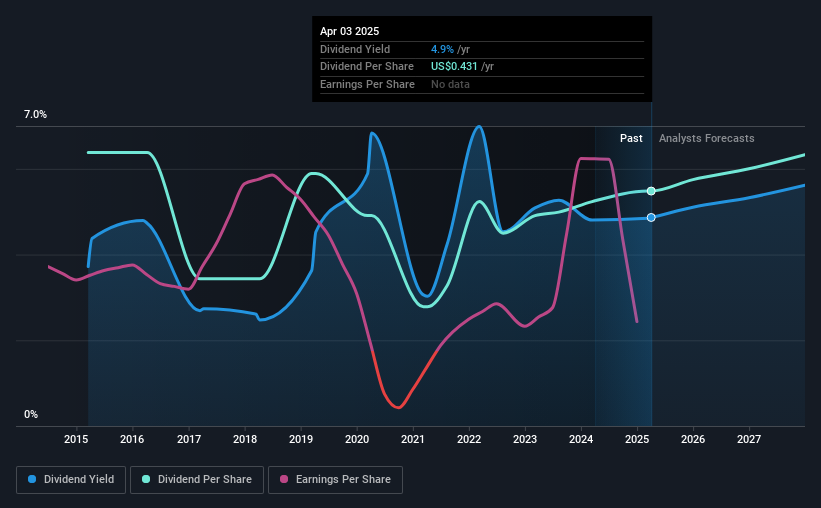
Readers hoping to buy Swire Pacific Limited (HKG:19) for its dividend will need to make their move shortly, as the stock is about to trade ex-dividend. Typically, the ex-dividend date is two business days before the record date, which is the date on which a company determines the shareholders eligible to receive a dividend. The ex-dividend date is important because any transaction on a stock needs to have been settled before the record date in order to be eligible for a dividend. Accordingly, Swire Pacific investors that purchase the stock on or after the 9th of April will not receive the dividend, which will be paid on the 9th of May.
The company's upcoming dividend is HK$2.10 a share, following on from the last 12 months, when the company distributed a total of HK$3.35 per share to shareholders. Based on the last year's worth of payments, Swire Pacific stock has a trailing yield of around 4.9% on the current share price of HK$68.85. Dividends are a major contributor to investment returns for long term holders, but only if the dividend continues to be paid. That's why we should always check whether the dividend payments appear sustainable, and if the company is growing.
If a company pays out more in dividends than it earned, then the dividend might become unsustainable - hardly an ideal situation. Last year, Swire Pacific paid out 110% of its income as dividends, which is above a level that we're comfortable with, especially if the company needs to reinvest in its business. Yet cash flows are even more important than profits for assessing a dividend, so we need to see if the company generated enough cash to pay its distribution. It paid out 78% of its free cash flow as dividends, which is within usual limits but will limit the company's ability to lift the dividend if there's no growth.
It's disappointing to see that the dividend was not covered by profits, but cash is more important from a dividend sustainability perspective, and Swire Pacific fortunately did generate enough cash to fund its dividend. Still, if the company repeatedly paid a dividend greater than its profits, we'd be concerned. Very few companies are able to sustainably pay dividends larger than their reported earnings.
Check out our latest analysis for Swire Pacific
Click here to see the company's payout ratio, plus analyst estimates of its future dividends.

Have Earnings And Dividends Been Growing?
Companies with falling earnings are riskier for dividend shareholders. If earnings fall far enough, the company could be forced to cut its dividend. Swire Pacific's earnings per share have fallen at approximately 12% a year over the previous five years. Such a sharp decline casts doubt on the future sustainability of the dividend.
Many investors will assess a company's dividend performance by evaluating how much the dividend payments have changed over time. Swire Pacific's dividend payments per share have declined at 1.5% per year on average over the past 10 years, which is uninspiring.
The Bottom Line
Is Swire Pacific an attractive dividend stock, or better left on the shelf? Earnings per share have been shrinking in recent times. Additionally, Swire Pacific is paying out quite a high percentage of its earnings, and more than half its cash flow, so it's hard to evaluate whether the company is reinvesting enough in its business to improve its situation. Bottom line: Swire Pacific has some unfortunate characteristics that we think could lead to sub-optimal outcomes for dividend investors.
With that in mind though, if the poor dividend characteristics of Swire Pacific don't faze you, it's worth being mindful of the risks involved with this business. Our analysis shows 3 warning signs for Swire Pacific and you should be aware of them before buying any shares.
Generally, we wouldn't recommend just buying the first dividend stock you see. Here's a curated list of interesting stocks that are strong dividend payers.
Have feedback on this article? Concerned about the content? Get in touch with us directly. Alternatively, email editorial-team (at) simplywallst.com.
This article by Simply Wall St is general in nature. We provide commentary based on historical data and analyst forecasts only using an unbiased methodology and our articles are not intended to be financial advice. It does not constitute a recommendation to buy or sell any stock, and does not take account of your objectives, or your financial situation. We aim to bring you long-term focused analysis driven by fundamental data. Note that our analysis may not factor in the latest price-sensitive company announcements or qualitative material. Simply Wall St has no position in any stocks mentioned.